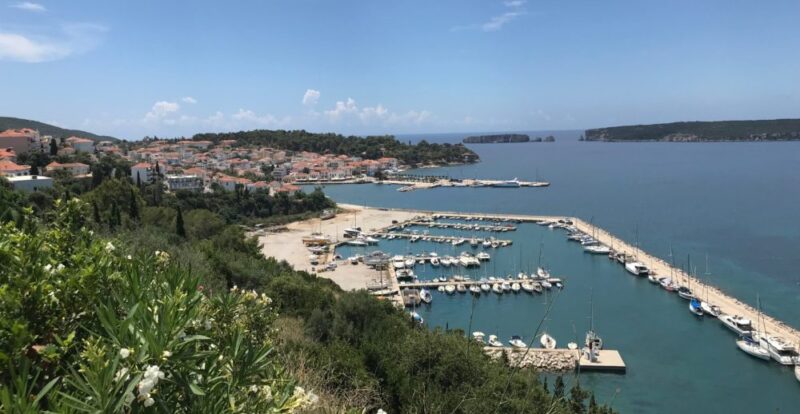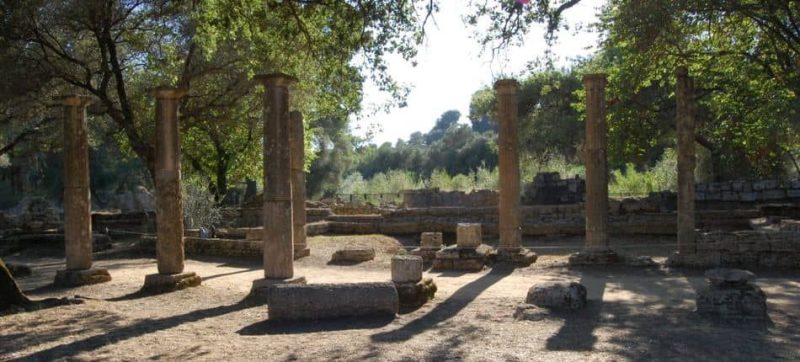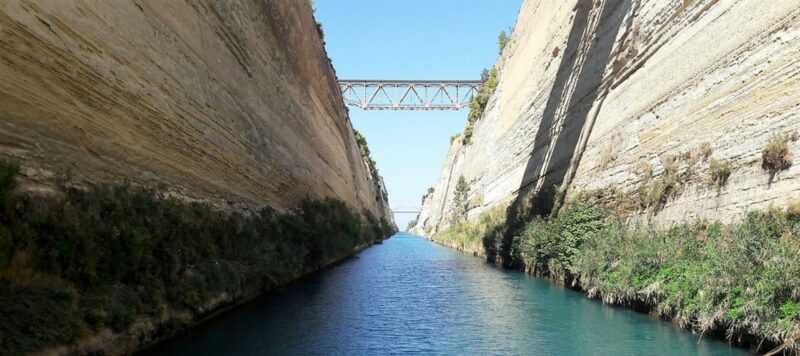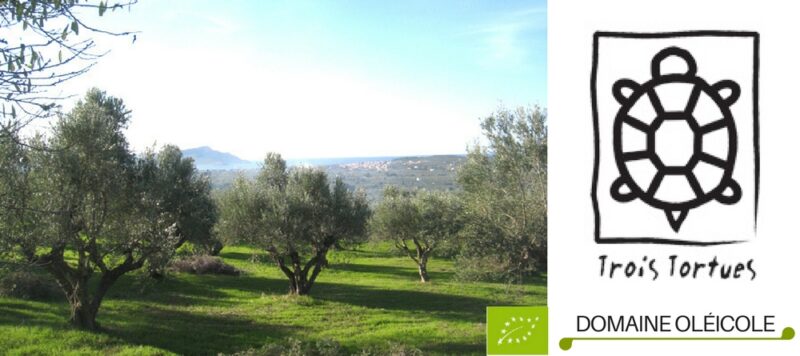It’s impossible not to fall under Monemvasia’s spell. A “fortified rock”, accessible only by bridge. Facing the sea, the fortified town hides from the world, but offers its visitors unparalleled charm and an incredible panorama of the Mediterranean. Much coveted, it has seen a succession of eras and invaders, appropriating its architecture, customs and religions over the centuries.
- Geography
- History of Monemvasia
- What to do in Monemvasia
- Practical information: where to sleep? where to eat? how to get to Monemvasia?
Geographical location
Located in the south-eastern Peloponnese, the town of Monemvassia is nestled on a rock. Naturally protected on the landward side by the rock, the town’s ramparts were only built to protect it from potential invaders from the sea. What’s more, the steep coastline made it difficult for boats to dock, further strengthening the natural defense.
With its focus firmly on the sea, Monemvassia was a hub of Mediterranean trade. Strategically located between Europe and the East, it was at the crossroads of civilizations and numerous exchanges. At its peak, the town had a population of over 8,000.
Monemvasia, the impregnable fortress
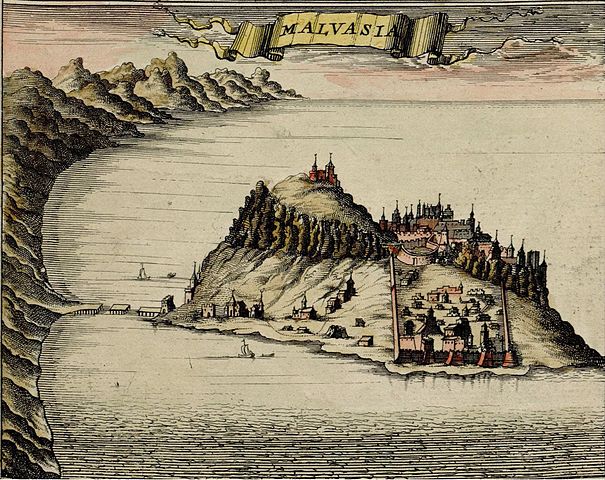
The first inhabitants
The first traces of settlement date back more than 8,000 years. Monemvasia was then known as Cape Minoa and was a strategic port for those linking the mainland with the Cyclades and Crete, then in full development.
In 375 BC, an earthquake changed the configuration of the site. The Laconian coast was submerged by the waters and several towns were swallowed up. As for the “rock”, the western part was covered by the sea, separating it from the mainland and forming an island.
In 582/583 AD, the Laconians built the foundations of a village. Fleeing Arab and Visigoth incursions, they found refuge on this inaccessible coastline offering natural protection. It was at this time that the first bridge was built to link the rock of Monemvasia to the mainland.
Byzantine period
During the Byzantine period, the city strengthened its protection. Walls were built and the town expanded in its lower part near the sea. Thanks to its geographical location, the town was not only an ideal military stronghold, but also a religious center. Monemvasia grew and developed thanks to its naval and merchant activities.
In 1204, the Franks conquered the Byzantine Empire. Monemvasia remained unbeaten for 40 years. Realizing that the rock could not be taken, the Franks laid siege to it. For three years, the inhabitants resisted. Even at their wits’ end, they succeeded in imposing the conditions of their remission: their freedom and exemption from taxes and military service in the conquering army.
When the Byzantine Empire returned to power, Monemvassia regained its place and grandeur. By imperial decree, the city was granted a number of privileges: exemption from taxes and customs duties, as well as freedom of movement for ships throughout the empire. This is how Monemvasia reached its apogee in the 13th and 14th centuries. At that time, the town had a population of 8,000 and 40 churches.
Venetian and Turkish invasions
In 1463, Monemvasia was the last place in the Byzantine Empire to fall. It was then occupied successively by the Venetians (1463-1540 and 1690-1715) and the Turks (1540-1690 and 1715-1821).
In 1821, it was again the first fortress to be liberated by fighters in the Greek War of Independence. After liberation, fighting between rival factions for control of the fortress led to the town’s decline. Gradually, the inhabitants settled on the mainland at Gefira on the other side of the bridge.
Today, there are very few year-round residents in Monemvasia. The historic site is home to a number of shops and, above all, hotels, all of which must comply with the architectural standards of historic monuments (materials, construction…).
What to do in Monemvasia
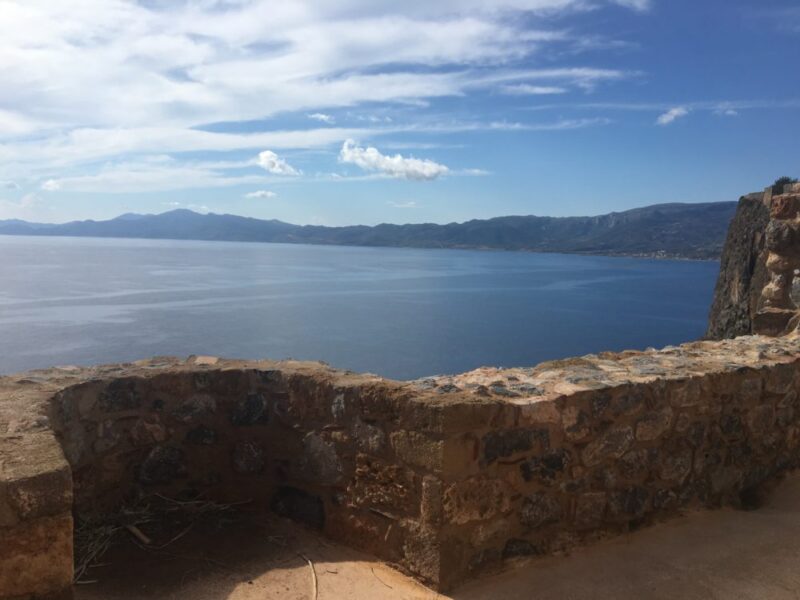
Guided tour
If you can, we recommend you take a guide with you on your tour of Monemvasia. As you make your way through the maze of streets in the lower town, and then up to the Kastro in the upper town, the explanations you’ll receive will give you a better grasp of history.
Climb to the top of the Kastro to the Church of Saint Sophia
It’s a short walk (30 min – 45 min if you’re not used to it). Be careful, the path is cobbled and can be very slippery (especially on the way down). But it’s worth it! From the top you have a breathtaking view of the entire site. Saint Sophia has seen a succession of eras, bearing the traces of the Byzantine Empire as well as Turkish domination. You’ll also discover the ruins of the upper town: the fort and the family dwellings.
Strolling through the lower town
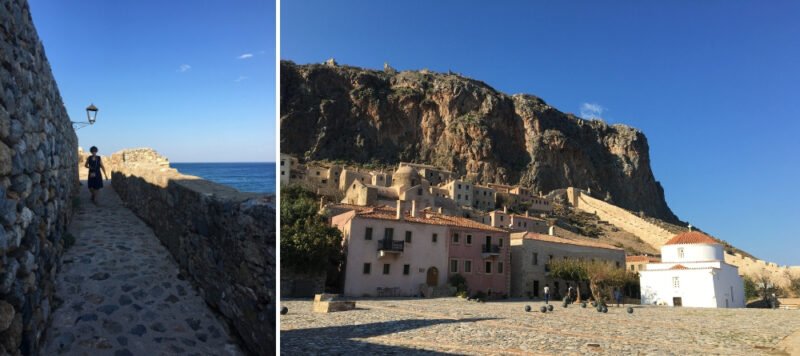
The town of Monemvasia has just one shopping street, concentrated in the first 100 meters after the main gate. On this stretch of the road, you’ll find “tourist” shops of varying degrees of taste. We recommend the Edodimopolio store, which sells excellent locally-produced olive oil, as well as mead and the famous Malvasia wine.
The rest of the old town is more picturesque and a pleasure to get lost in. Venetian houses, small Byzantine churches and staircases intermingle before leading to the sea. Hoteliers have taken over the dwellings to turn them into charming hotels, while preserving the spirit of the place. We’ll show you
where to stay in Monemvasia.
in the following article. As Monemvasia is an archaeological site, renovations are very strict in terms of the materials used and respect for the architecture.
Tour the ramparts
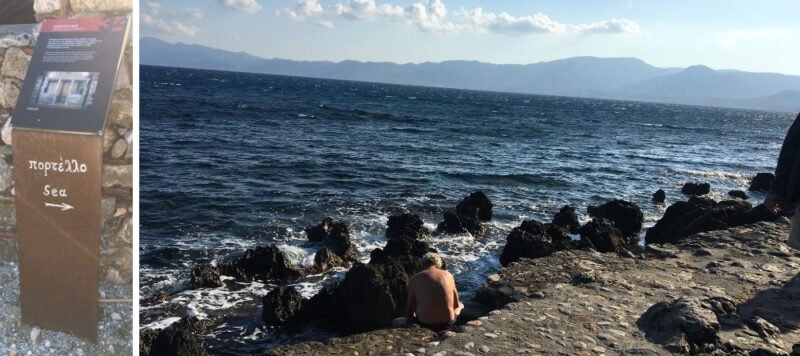
Running along the seafront, the ramparts offer a beautiful panorama of the town and the sea. If you go as far as the Eastern Gate, nature takes over once again. Then, due south, you’ll see a sign “πορτελλο– sea“, follow it to get to the platform overlooking the sea. Bathing is possible by descending ladders. The view of the city from the sea is really pretty. However, don’t attempt to swim in strong winds or rough seas.
Spend a night in the Kastro
If you have the time, don’t miss out on the magic of a night in the old town. Firstly, because you’ll enjoy almost deserted streets in the early hours of the morning, and secondly, because you’ll enjoy a moment out of time. The town boasts some good restaurants and they are not overpriced.
As for hotels, thereare plenty to choose from. Choose wisely, though, because sometimes the rooms are located in old cellars, and although they have been renovated, they are damp and not very bright.
If you have more time: beaches, a small port and why not an island?
A few kilometers from Monemvasia, don’t miss the “unsuspected” little port of Limni Ieraka (sometimes spelled Geraka). Ultra-protected, it nestles in an arm of the sea. A few taverns line the quay, where you can sample the fruits of the peach. It’s also the start of a short walk to the ancient Acropolis of Zarax (45min), from where you’ll have a beautiful view of the site.
On the farniente side, there’s a lovely sandy beach just a few kilometers from Monemvasia on Pori Beach. The beach at Kochilas is a little wilder, but still made of pebbles. Heading south, you can also swim on the sandy beaches of Xyphias or Ambelakia.
Finally, you can drive to the other side of the “finger”. From here, boats leave for Kythera at Neapoli (45min). You can also reach the island of Elafonissos by ferry at Vigklafia, in just 10 minutes. A small paradise with sumptuous beaches. One of our favorites!
Sophie B.

